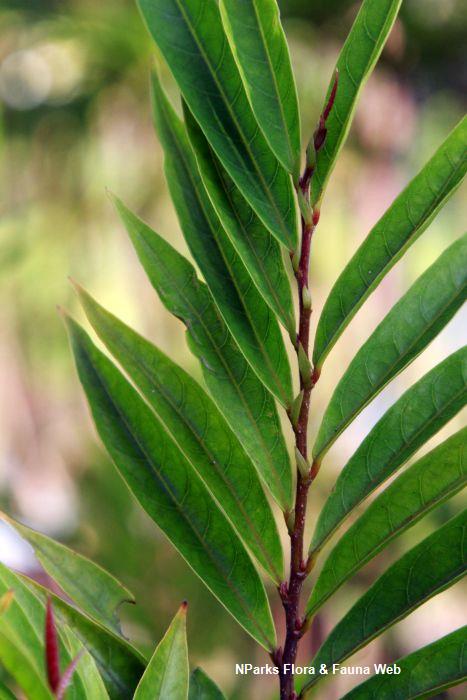
Back
Antidesma bunius
| Family Name: | Phyllanthaceae |
| Synonyms: | Antidesma squamosus |
| Common Name: | Chinese Laurel, Currantwood, Buni, Berunai, Bignay, 五月茶, 枯里珍树 |
Name
Classifications and Characteristics
| Plant Division | Angiosperms (Flowering Seed Plants) |
|---|---|
| Plant Growth Form | Tree (Medium (16m-30m), Shrubby (1m-5m)) |
| Lifespan (in Singapore) | Perennial |
| Mode of Nutrition | Autotrophic |
| Maximum Height | 3 m to 10 m |
Biogeography
| Native Distribution | India to Australia |
|---|---|
| Native Habitat | Terrestrial |
| Preferred Climate Zone | Tropical |
| Local Conservation Status | Non-native (Spontaneous (Casual)) |
Description and Ethnobotany
| Others - Plant Morphology | Antidesma bunius is a dioecious (male and female organs in separate and distinct individuals) tree that is about 3 – 10 m tall, has a straight trunk and usually branched near the base. Leaves are arranged alternately in two vertical rows on opposite sides of an axis (distichous), oblong-lancheolate. Male flower is sessile, attached by the base, without any distinct projecting support whereas female flower is pedicelled, a small stalk. Fruit will change colour from yellowish-red, unripe, to bluish-violet, ripe. It is juicy and the skin is thin but tough.It can be easily propagated by seed and reacts well to stem-cutting, marcotting, budding and grafting. Marcots, of 2 – 5 cm in diameter, are normally able to produce roots in 95 days. Most female trees are able for adequate pollination since it will produce enough perfect flowers. After planting for 4 – 5 years, seedling trees will start to produce fruits and the fruit season will last for two months only.Ripe fruits can be eaten raw but will stain fingers and mouth. Unripe berries tasted sour.As the berries do not ripe evenly in a bunch, the fruit is often used to produce jams or jelly. Juice, from fully ripened fruits, is a refreshing drink and used to produce an excellent wine.The immature fruits and young leaves are used as a substitute for vinegar.Young leaves are also used in the preparation of salads, cooked with food and can be eaten.As the fruits changes colour in different stages, it makes the tree an ornamental trees. |
|---|---|
| Ethnobotanical Uses | Edible Plant Parts : Edible Fruits, Edible Leaves Food (Fruit or Vegetable) (Herb or Spice) Medicinal: Juice from the fruits is used to treat heart diseases and high blood pressure. The leaves are used to treat coughs, indigestion, syphilis and gonorrhea. Cultural / Religious: Heritage Trees : There is currently one individual of Antidesma bunius listed as a Heritage Tree in Singapore. It can be found at Singapore Botanic Gardens. To find out more about these trees, please visit the Heritage Tree Register. |
Landscaping Features
| Desirable Plant Features | Ornamental Fruits |
|---|---|
| Landscape Uses | Suitable for Roadsides |
| Thematic Landscaping | Economic Garden |
Fauna, Pollination and Dispersal
| Fauna Pollination Dispersal Associated Fauna | Bird-Attracting |
|---|
Plant Care and Propagation
| Light Preference | Full Sun |
|---|---|
| Water Preference | Moderate Water |
| Plant Growth Rate | Moderate |
| Propagation Method | Seed, Stem Cutting, Grafting, Marcotting |
Foliar
| Mature Foliage Colour(s) | Green |
|---|---|
| Foliar Shape(s) | Non-Palm Foliage (Lanceolate, Oblong) |
| Foliar Apex - Tip | Acuminate, Obtuse |
| Foliar Base | Rounded / Obtuse |
| Leaf Area Index (LAI) for Green Plot Ratio | 3.0 (Tree - Intermediate Canopy) |
Floral (Angiosperm)
| Flower & Plant Sexuality | Unisexual Flowers , Dioecious |
| Flower Colour(s) | Red |
|---|
Fruit, Seed and Spore
| Mature Fruit Colour(s) | Blue, Purple |
|---|
Image Repository
Others
| Master ID | 1421 |
|---|---|
| Species ID | 2714 |
| Flora Disclaimer | The information in this website has been compiled from reliable sources, such as reference works on medicinal plants. It is not a substitute for medical advice or treatment and NParks does not purport to provide any medical advice. Readers should always consult his/her physician before using or consuming a plant for medicinal purposes. |

_lowres.jpg)
_lowres.jpg)










_lowres.jpg)
_lowres.jpg)
_lowres.jpg)
_lowres.jpg)
_lowres.jpg)
_lowres.jpg)


